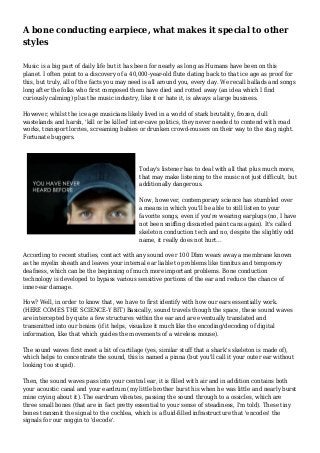
A bone conducting earpiece, what makes it special to other styles
- 1. A bone conducting earpiece, what makes it special to other styles Music is a big part of daily life but it has been for nearly as long as Humans have been on this planet. I often point to a discovery of a 40,000-year-old flute dating back to that ice age as proof for this, but truly, all of the facts you may need is all around you, every day. We recall ballads and songs long after the folks who first composed them have died and rotted away (an idea which I find curiously calming) plus the music industry, like it or hate it, is always a large business. However, whilst the ice age musicians likely lived in a world of stark brutality, frozen, dull wastelands and harsh, 'kill or be killed' inter-cave politics, they never needed to contend with road works, transport lorries, screaming babies or drunken crowd-rousers on their way to the stag night. Fortunate buggers. Today's listener has to deal with all that plus much more, that may make listening to the music not just difficult, but additionally dangerous. Now, however, contemporary science has stumbled over a means in which you'll be able to still listen to your favorite songs, even if you're wearing earplugs (no, I have not been sniffing discarded paint cans again). It's called skeleton conduction tech and no, despite the slightly odd name, it really does not hurt... According to recent studies, contact with any sound over 100 Dbm wears away a membrane known as the myelin sheath and leaves your internal ear liable to problems like tinnitus and temporary deafness, which can be the beginning of much more important problems. Bone conduction technology is developed to bypass various sensitive portions of the ear and reduce the chance of inner-ear damage. How? Well, in order to know that, we have to first identify with how our ears essentially work. (HERE COMES THE SCIENCE-Y BIT) Basically, sound travels though the space, these sound waves are intercepted by quite a few structures within the ear and are eventually translated and transmitted into our brains (if it helps, visualize it much like the encoding/decoding of digital information, like that which guides the movements of a wireless mouse). The sound waves first meet a bit of cartilage (yes, similar stuff that a shark's skeleton is made of), which helps to concentrate the sound, this is named a pinna (but you'll call it your outer ear without looking too stupid). Then, the sound waves pass into your central ear, it is filled with air and in addition contains both your acoustic canal and your eardrum (my little brother burst his when he was little and nearly burst mine crying about it). The eardrum vibrates, passing the sound through to a ossicles, which are three small bones (that are in fact pretty essential to your sense of steadiness, I'm told). These tiny bones transmit the signal to the cochlea, which is a fluid-filled infrastructure that 'encodes' the signals for our noggin to 'decode'.
- 2. Bone conduction tech vibrates the bones of your skull, sending the noise directly to a cochlea and bypassing the remainder of their ear totally. The nerve impulses transmitted to the brain are exactly the same, however the sensitive instrument of the ear doesn't have to deal with the hassle of, to cite Anchorman's Brick Tamland "LOUD NOISES!" This method seems to be completely safe; in fact, the notably deaf composer Beethoven employed a elementary version of this process to be able to create his most well-known works. He attached a rod between his piano and his head and, as such, was able to listen to the song he was playing. So there you go, rather then exposing your sensitive ears to louder and louder volumes, just to drown out the background noise, you are able to alternativily stick your earpugs in and play your music at the proper volume. Make no bones about it (groan!) http://www.tecommunications.com/?p=103